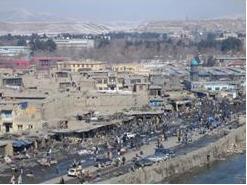
Murad Khane
WORLD MONUMENTS FUND
Reading time: (Number of words: )
WMF EVALUATION SUMMARY Review: Marika Sardar / WMF Staff: Angela M.H. Schuster
Kabul, Afghanistan 1700s – 1920 SIGNIFICANCE
The Murad Khane district of Kabul consists of several historic buildings on the north bank of the Kabul River at the heart of the city. In the early eighteenth century the land on which the district developed was granted by the king Ahmad Shah Durrani to the Qizilbash members of his court, and the Qizilbash ethnic group still makes up a major portion of the area’s population. Through the nineteenth and early twentieth centuries the district flourished and numerous buildings with intricately carved wood and plaster decoration were constructed. Many of these have been recently destroyed, first as part of a Soviet-inspired master plan for Kabul in 1975, and then in the civil war of the mid-1990’s. Those remaining include a famous shrine, a bathhouse, a market, and several courtyard houses.

THREAT The buildings in this historic district suffer from harsh weather conditions as well as the inability of owners to perform basic maintenance. Many historic structures have been torn down; some have been replaced by modern concrete developments, while other plots remain empty and are being used as garbage dumps. Recent efforts to preserve the district have come about because of President Hamid Karzai’s personal interest in saving one of the buildings; as a result, the Ministry of Culture, the Ministry of Urban Development, and the Kabul Municipality have recognized the Murad Khane as needing protection. However, other priorities in this war-torn and poverty-stricken country have prevented any further governmental action. In the meantime, the Turquoise Mountain Foundation has started some preservation work with funds secured from outside sources. The foundation’s goal is to preserve the buildings for the sake of the neighborhood’s inhabitants, who have petitioned the foundation for help.
VIABILITY The Turquoise Mountain Foundation was established in 2006 with the support of President Karzai. The organization’s mission is to invest in traditional crafts, historic buildings, and landscapes in order to preserve cultural heritage, improve living conditions, and create economic opportunities. The foundation has established the Centre of Traditional Arts and Architecture for Afghanistan and is working to restore some of Kabul’s most significant historic buildings. The Foundation has completed initial architectural, topographical, infrastructure, traffic, and socio-economic surveys of Murad Khane. It has measured, drawn, and documented eight key buildings and has begun major restoration work on the Sarwar House and the Peacock House. It has implemented a small program of emergency repairs on seven further buildings and has also begun work to clear solid waste from the area to prepare the foundations for a drainage and sanitation network. A development and conservation plan is in progress which aims to ensure the long-term survival and restoration of the historic townscape as well as meeting the basic needs of the impoverished local community. It is estimated that the entire project of preservation and maintenance will cost $4.9 million. An initial sum of $280,000 will enable the emergency stabilization and repair of ten buildings identified as being most at risk, while a further $2.2 million will fund the implementation of a comprehensive conservation program that will ensure their long term survival and use by the community. The Turquoise Mountain Foundation is an internationally registered NGO which manages an annual budget of $2.2 million. It has already secured grants for its previous work in Murad Khane from the British Embassy in Afghanistan, the governments of Kuwait and Bahrain, and the Abdul Latif Jameel Foundation.
ADDITIONAL CONSIDERATIONS PERTINENT TO WATCH LISTING Murad Khane is one of three nominations from Afghanistan this year and one of two from the Kabul area.

Poems for the Hazara
The Anthology of 125 Internationally Recognized Poets From 68 Countries Dedicated to the Hazara
Order Now









